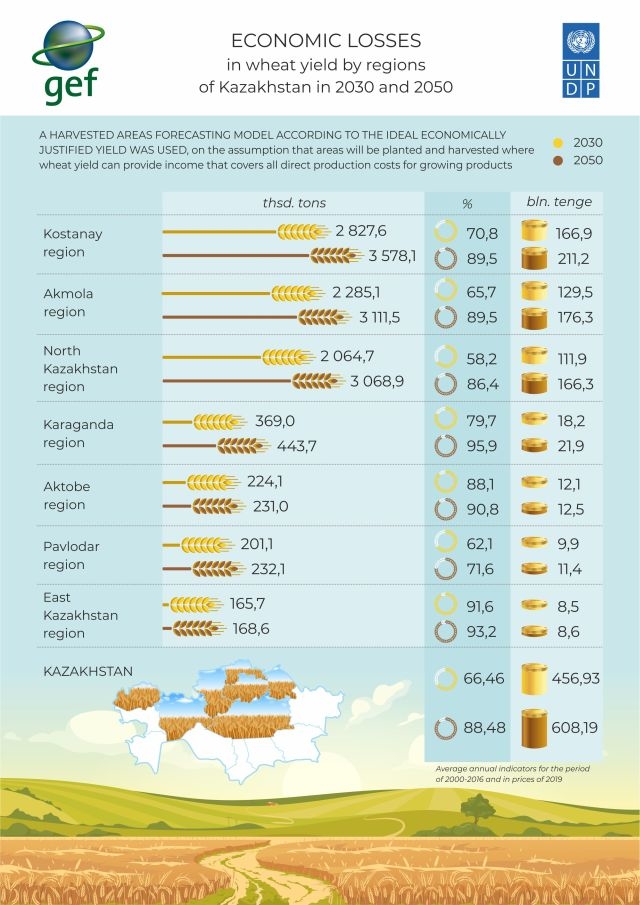
Although hunger eradication and undernourishment is not relevant to Kazakhstan, they remain one of the humanity’s most pressing problems globally. Between 1992 and 2017, significant progress was made in strengthening food security, with global undernourishment halved from 23% to 11%, however, the results were uneven across countries and regions.
According to the last The State of Food Security and Nutrition in the World Report 2020, almost 690 million people were starving in 2019 - 10 million more than in 2018 and almost 60 million more than in the past five years. The report predicts that the COVID-19 pandemic can cause the chronic hunger for additional 130 million people worldwide by the end of 2020, and pandemic-induced outbreaks of severe hunger can temporarily increase this number.
In this context, food security at the country and global levels becomes one of the priority objectives. Many global initiatives to address food security issues aim to promote the development of food and rural sectors by proposing sustainable climate change adaptation.
According to the Global Report on Food Crises, the majority of acutely food-insecure people in 2019 lived in conflict zones - 77 million, 34 million lived in climate change affected zones and 24 million - in zones of economic crisis. Agriculture, forestry and other land uses are responsible for nearly a quarter of greenhouse gas emissions. With emissions from the stages preceding and following food production, these emissions account for up to 37% of the total greenhouse gas emissions globally. Meanwhile, measures to reduce waste and excessive production and switching to local food sources, combined with the right diets, offer the opportunity to reduce emissions by as much as 12.5 Gt of CO2, which is comparable to the disappearance of 2.7 billion cars from the roads.
Food security forecasts for Kazakhstan
Kazakhstan, being one of the biggest suppliers of grain and grain products, is an important link for a larger region of Central Asia. Kazakhstan plans to increase its livestock headcount to supply 100% of domestic meat demand, but faces the issue of limited quality and availability of pastures, which are also affected by climate change. Could this become a barrier for government plans and regional development?
In 2019, UNDP supported the assessment of the wheat and range sheep production sectors’ vulnerability to climate change and their state under the expected climatic conditions was predicted until 2050.
Wheat
The assessment showed that under the expected climatic conditions, the average yield of spring wheat in 2030 will be 63-87% of its current level in seven regions of interest (Akmola, Aktobe, West Kazakhstan, Karaganda, Kostanay, Pavlodar, North Kazakhstan oblasts) and under the expected conditions in 2050 it will be 51-80%. This means that if current farming practices do not change, the yield of spring wheat will decrease by 13-37% by 2030, with the harvested area shrinking by 23-81%, while direct economic losses in the sector will amount to 456.93 billion KZT in 2019 prices. And by 2050 the loss of wheat yields will be 20-49%, reducing the gross output in the sector by up to 608.19 billion KZT in 2019 prices. Given the fact that Kazakhstan is the world’s 9th largest producer and 7th largest exporter of wheat and the only exporter in Central Asia, the lack of climate change adaptation measures in Kazakhstan could pose a threat to food security of the entire region.
The main reasons for the projected wheat yields decline are:
- declining water availability during the growing season by 8-17% in the forecasts until 2050, caused by the growing evaporation due to higher air temperatures. The expected climate change will drive the shift of thermal and humid zones to the north;
- increasing thermal resources by 12-16% in the forecasts until 2050, which is higher than the optimal value for the growth and ripening of spring wheat;
- increasing climate aridity with dropping values of the Hydrothermal Coefficient (HTC) by 7-15% in the forecasts until 2050. The frequency of droughts and dry winds will also increase accordingly;
- imperfection of the applied farming practices and lack of advanced technologies both for production and storage of finished products;
- monoculture farming posing a threat of small and medium-sized farms’ bankruptcy in case of adverse weather events. A partial transition to crops that are better suited to a changing climate, for example, sunflower, which according to research gives a higher yield if affected by higher temperatures, is seen as the most optimal solution under these conditions, since crop diversification can compensate for the loss of wheat and other crops, which will suffer from changes in the external environment.
Pastures
In recent years Kazakhstan’s livestock production sector has seen an annual death of cattle - up to 17,000 heads, sheep and goats - up to 61,000 heads, horses - up to 5,000 heads, camels - up to 980 heads and pigs - up to 42,000 heads. Unfortunately, the Committee on Statistics of the Ministry of National Economy of the Republic of Kazakhstan does not keep records of the causes of livestock death, however one can make an assumption that some deaths can be attributed to climatic changes - unfavorable weather events and a lack of feed.
The existing pastures are highly vulnerable to climate change. In the baseline period from 2000 to 2016 the average area of pastures in seven regions of interest (Aktobe, Almaty, Zhambyl, Karaganda, Kyzylorda, Mangystau, South Kazakhstan oblasts) was 117 million hectares (all types of pastures). According to the current standards on the maximum allowable stocking level, it is possible to sustainably keep about 40.4 million heads of small cattle on this territory, while the actual amount of small cattle in these oblasts was 10.9 million heads. Thus, pastures are used at the 27% of their total capacity. The pasture use in these oblasts is as follows:
· Aktobe (10.6%);
· Almaty (53.0%);
· Zhambyl (49.8%);
· Karaganda (7.7%);
· Kyzylorda (23.1%);
· Mangystau (11.8%);
· South Kazakhstan (84.2%).
Today, there is an untapped potential to increase the number of animals and gross output in sheep breeding, and if the pasture capacities are fully used, the industry can generate 1.1 trillion KZT of gross output in 2019 prices.
However, climate change can diminish the stocking capacity of pastures, which could potentially lead to product losses in the industry. According to the UNDP project experts, under the influence of the climate change scenario RCP 4.5, 9.8% decrease of pasture stocking capacity is possible in seven regions of interest by 2030, which can lead to potential economic losses in the amount of 109.0 billion KZT. By 2050, pasture stocking capacity will decrease by 15.2%. At the same time, potential economic losses will be equal to 169.6 billion KZT.
Adaptation measures
The above risks of climate change related agricultural productivity loss in Kazakhstan (in wheat production and pastures) can be mitigated through the introduction of adaptation measures. For instance, measures to enhance the wheat production can include: breeding of new drought-resistant varieties of wheat; breeding of new adaptive varieties of wheat that can bring a guaranteed yield regardless of the weather during the growing season; introduction of moisture-saving technologies, for example, no-till, etc.
Measures to diversify production in order to keep the arable lands operational include: selection and cultivation of more draught-resistant crops, such as sorghum, as well as development of feed production for livestock in climate-affected areas, which will add value to the final product and help improve the overall profitability of agricultural production.
Measures for better access to distant pastures and sustainable use of pastures include: encourage the development of distant pastures by making them operational via watering; facilitate the development of large-scale agricultural production in distant-pasture cattle breeding industry; better control over the sustainable use of agricultural lands including the use of modern space monitoring tools and information systems of the Ministry of Agriculture. It is important to amend the land legislation and develop new mechanisms for the allocation and redistribution of lands and/ or their parts for agricultural purposes to ensure more effective redistribution of unsustainably used agricultural lands; reform the land legislation to facilitate a regime of granting a right of using the allocated agricultural pasture lands by third-party users, provided that the allowable stocking limits are not exceeded, limit the preemptive assigned lessor’s right to use the lands if they are used unsustainably, as well as monitor and register animals and their health using information systems and respective structural divisions of the Ministry of Agriculture.
Thus, farming is seen as one of the most vulnerable sectors of the economy, and assessment of different crops’ vulnerability is a critical task for the integrated production and marketing of plant products. Gardens, fields, pastures, flooded meadows, fruit canning, growing and processing of cereals, melons and gourds, logistics have their limit of resistance to climate change. Kazakhstan clearly needs an appropriate climate change adaptation strategy. And drafting a special section in the country's commitments under the Paris Agreement - clarification and modification of the Nationally Determined Contributions document - will mean mainstreaming adaptation measures into national programs and legislation.
Source: https://www.kz.undp.org/content/kazakhstan/en/home/stories/2020/kazakhstan-may-suffer-economic-losses-in-wheat-production-due-to.html


